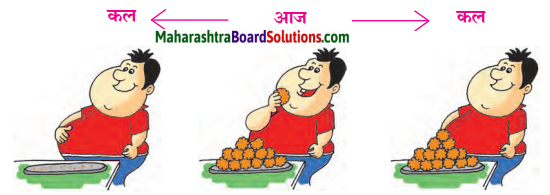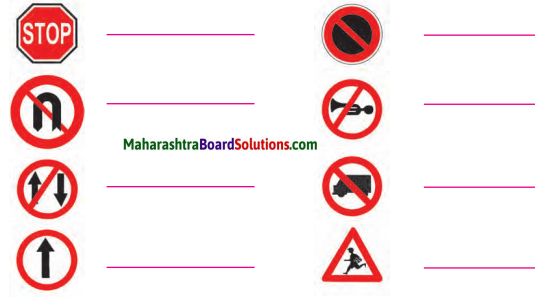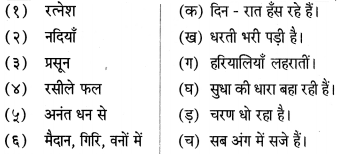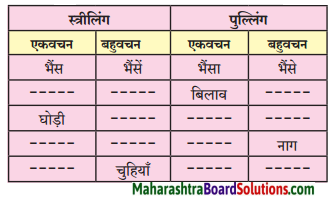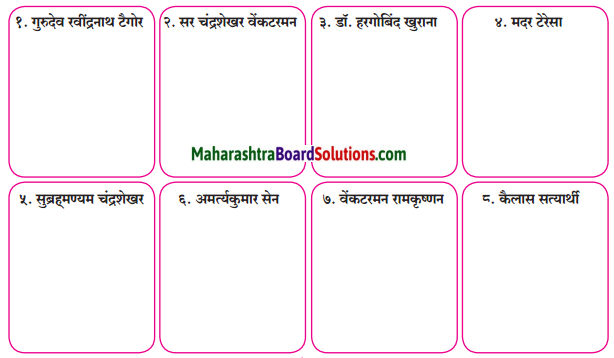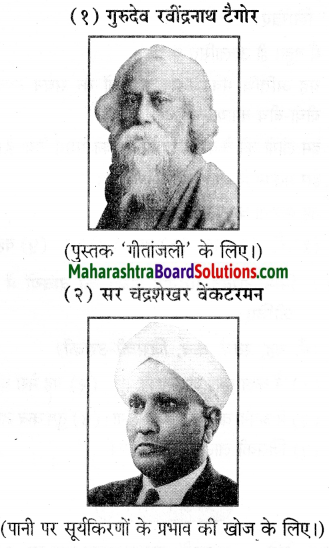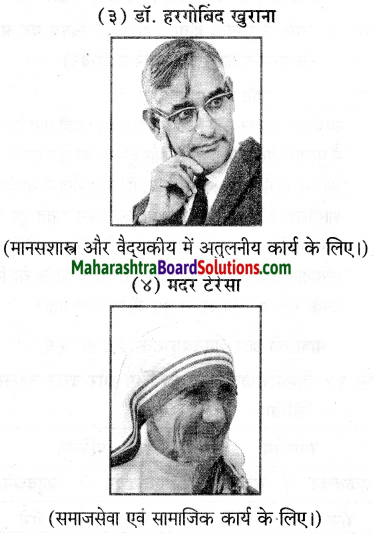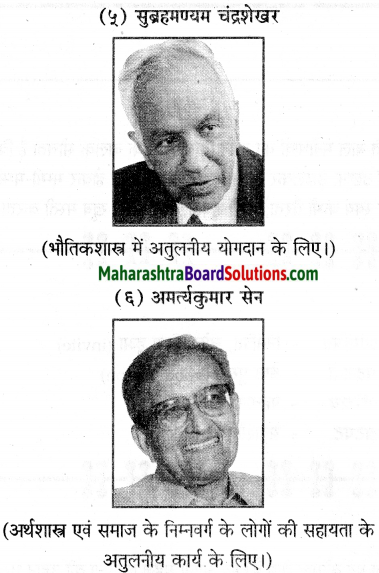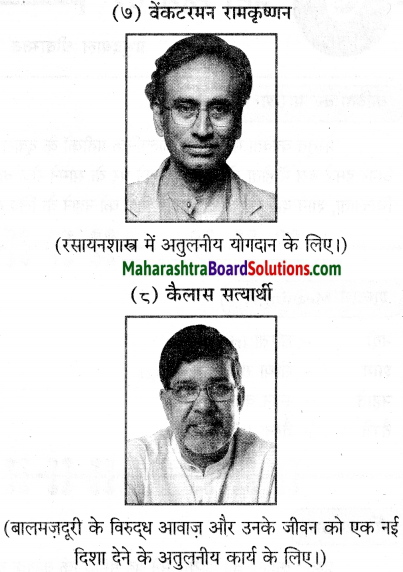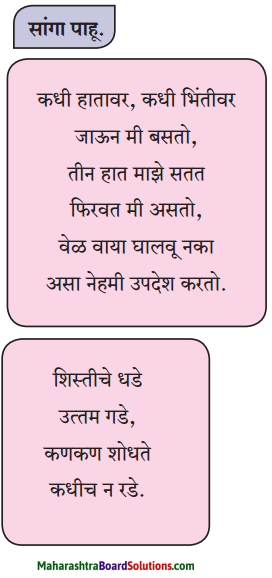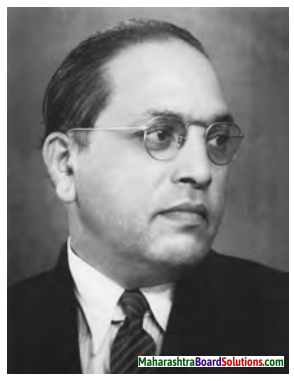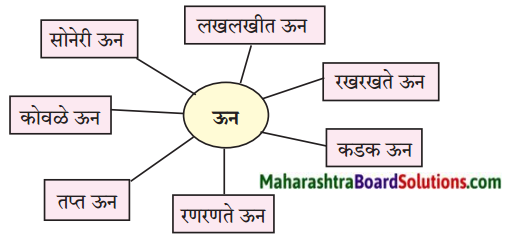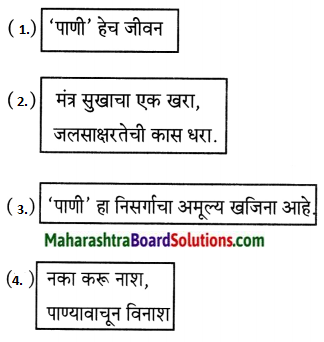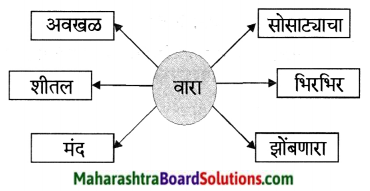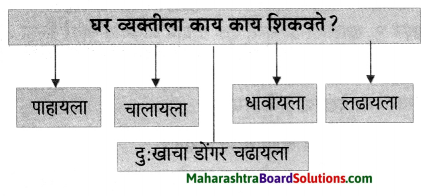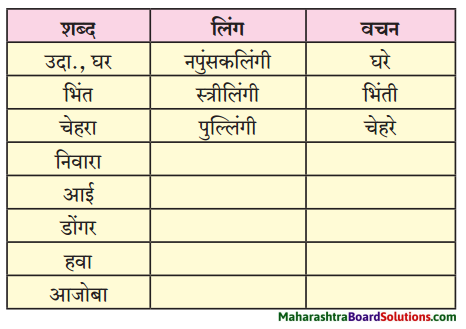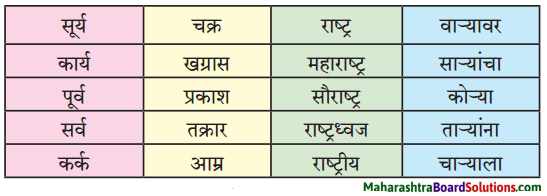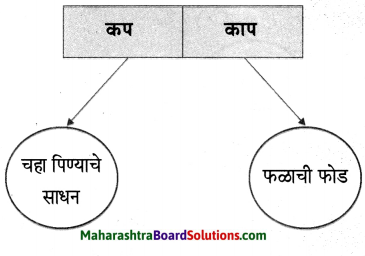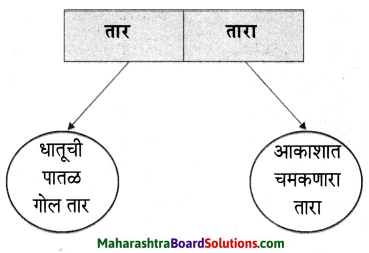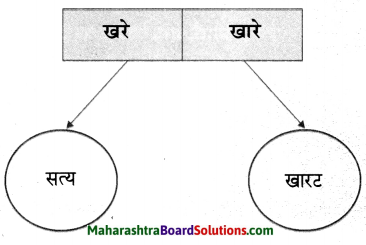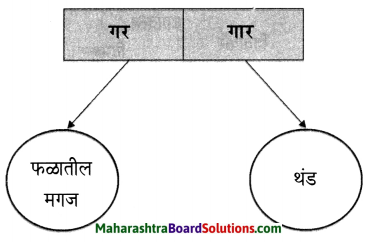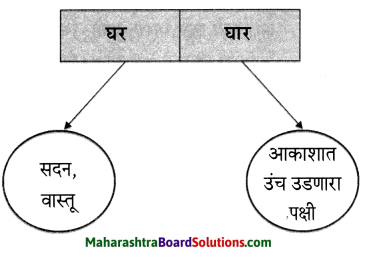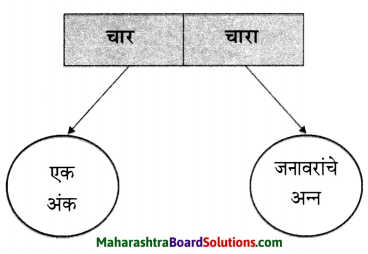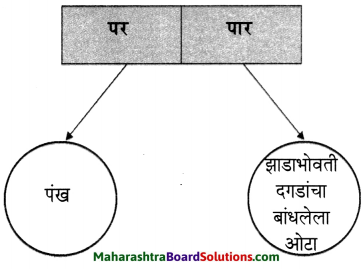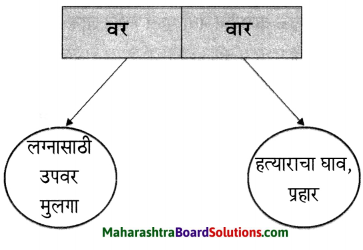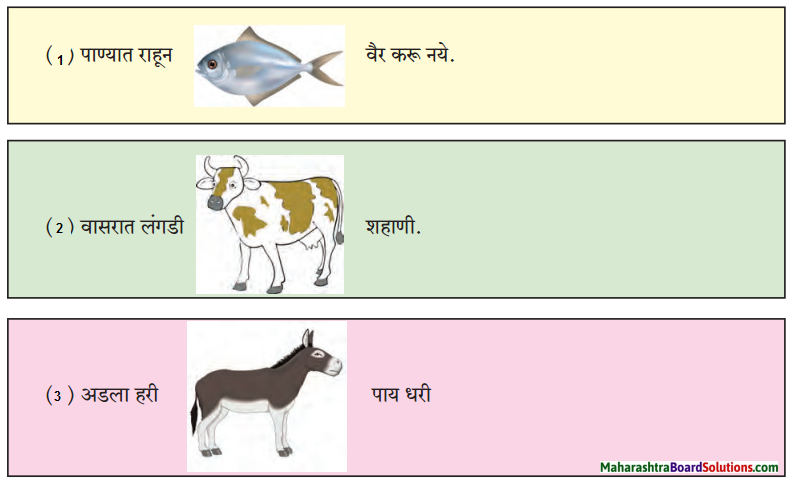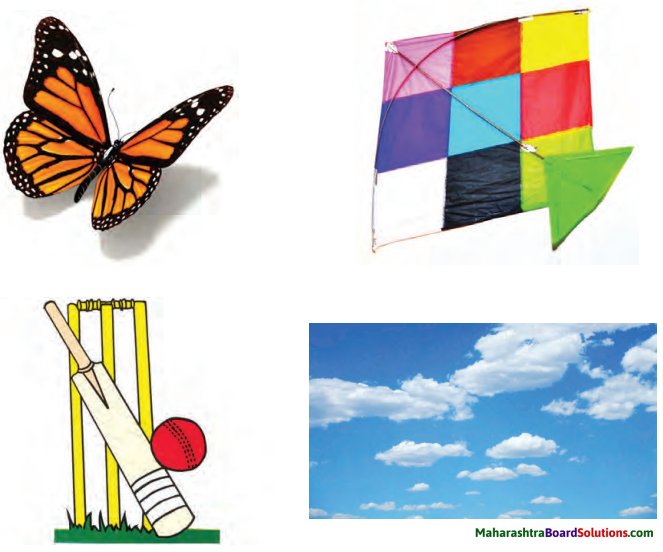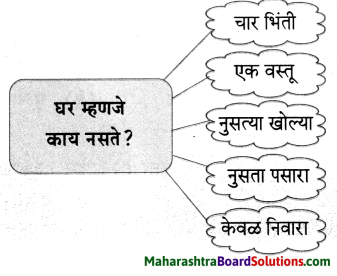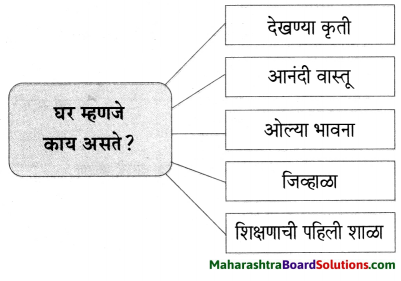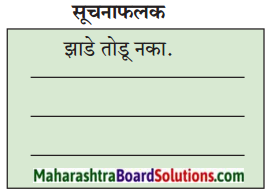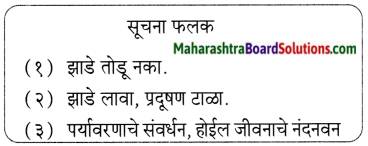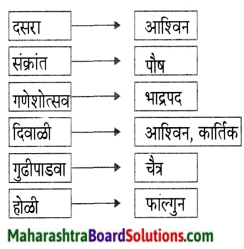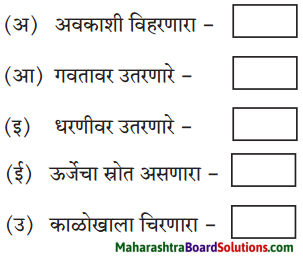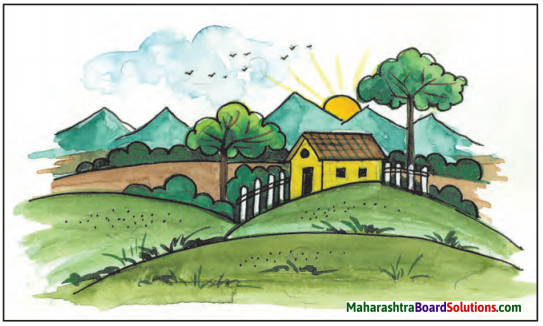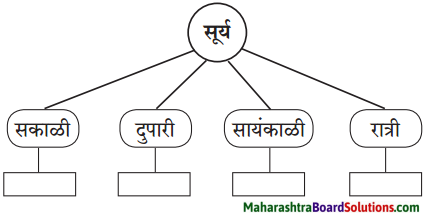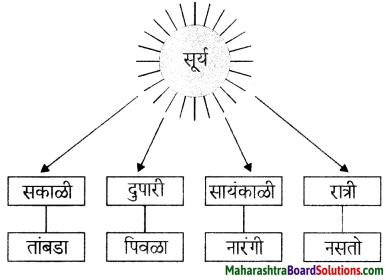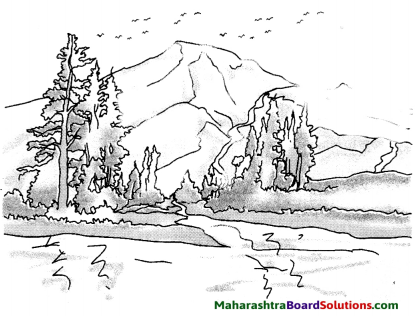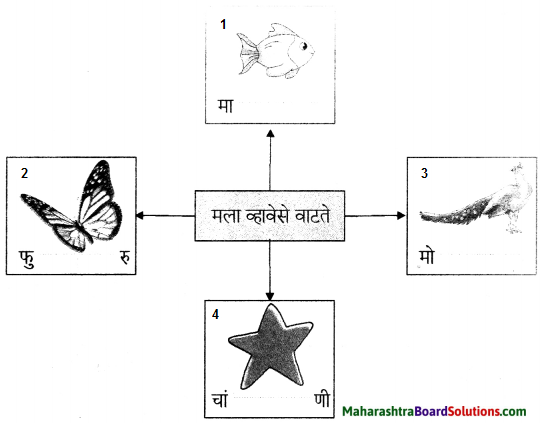Balbharti Maharashtra State Board Class 6 Marathi Solutions Sulabhbharati Chapter 13 मोठी आई Notes, Textbook Exercise Important Questions and Answers.
Class 6th Marathi Chapter 13 मोठी आई Question Answer Maharashtra Board
Std 6 Marathi Chapter 13 Question Answer
Marathi Sulabhbharti Class 6 Solutions Chapter 13 मोठी आई Textbook Questions and Answers
1. एका वाक्यात उत्तर लिहा.
प्रश्न अ.
घर बांधण्यासाठी कोणकोणत्या वस्तू लागतात?
उत्तर:
दगड, माती, विटा, चुना व लाकूड इत्यादी या वस्तू घर बांधण्यासाठी लागतात.
प्रश्न आ.
जमिनीच्या पोटात कोणकोणती खनिजे सापडतात?
उत्तर:
चांदी, रूपे, पितळ, तांबे, कथील, दगडी कोळसा, लोखंड इ. खनिजे जमिनीच्या पोटात सापडतात.
प्रश्न इ.
कारखान्यात धातूपासून कोणकोणत्या वस्तू तयार होतात?
उत्तर:
लोखंडी खुा, पलंग, सुया, टाचण्या, चाकू, कात्र्या, गुंड्या, काचेचे सामान, मोटारी, आगगाड्या, विमाने इत्यादी वस्तू कारखान्यात धातूपासून तयार होतात.
प्रश्न ई.
चुना कशासन तयार करतात?
उत्तर:
चुनखडीच्या खडकापासून चुना तयार करतात.
प्रश्न उ.
लेखिकेच्या मते मातृभूमीबद्दल प्रेमभाव का बाळगावा?
उत्तर:
माणसांना प्रत्येक गोष्ट या भूमीनेच दिली आहे, म्हणून लेखिकेच्या मते मातृभूमीबद्दल प्रेमभाव बाळगायला हवा.
2. तुम्ही खात असलेल्या अन्नपदार्थांतील कोणकोणत्या वस्तू जमिनीकडून आपणांस मिळतात, यांची यादी बनवा.
प्रश्न 1.
तुम्ही खात असलेल्या अन्नपदार्थांतील कोणकोणत्या वस्तू जमिनीकडून आपणांस मिळतात, यांची यादी बनवा.
उत्तर:
- धान्य – ज्वारी, बाजरी, नाचणी, गहू, मळा, तांदूळ इ.
- कडधान्य – मूग, मटकी, चवळी, वाटाणा, हरभरा, वाल, तूर, उडीद इ.
- पालेभाज्या – मेथी, शेपू, तांदळी, चाकवत, पालक, माठ इ.
- फळभाज्या – वांगी, कोबी, फ्लॉवर, दुधीभोपळा, दोडका, कारले, टोमॅटो, गवार, शेवगा, भेंडी, घेवडा, राजमा इ.
- कंदमुळे – कांदा, गाजर, बीट, मुळा, रताळे, भुईमुगाच्या शेंगा इ.
- फळे – केळी, चिकू, पेरू, आंबा, फणस, अननस, द्राक्षे, सफरचंद, जांभळे, कवठ, बोरे, पपई, काजू, बदाम, अक्रोड इ.
3. आपण मातृभूमीबद्दल प्रेमभाव का बाळगायला हवा ते तुमच्या शब्दांत लिहा.
प्रश्न 1.
आपण मातृभूमीबद्दल प्रेमभाव का बाळगायला हवा ते तुमच्या शब्दांत लिहा.
उत्तर:
मातृभूमी म्हणजेच जमीन, काळी आई आपणास अन्न-वस्त्र देते, दाग-दागिने देते, घरदार देते, धनधान्य देते, भांडीकुंडी देते, पाटी-पेन्सिल देते. त्या भूमीतले अन्न खाऊनच आपण मोठे झालो, शहाणे झालो. माणसांना प्रत्येक गोष्ट दिली ती या भूमीनेच. माती आहे म्हणूनच आपण जिवंत आहोत. म्हणून अशा या दातृत्वपूर्ण मातृभूमीबद्दल प्रेमभाव बाळगायला हवा.
4. ‘मोठी आई’ साठी पाठात वापरले गेलेले शब्द शोधून लिहा.
प्रश्न 1.
‘मोठी आई’ साठी पाठात वापरले गेलेले शब्द शोधून लिहा.
उत्तर:
- भूमी
- जमीन
- भूमाता
- धरणीमाता
- मातृभूमी
- मायभूमी
5. पाटीपेन्सिल’ सारखे जोडशब्द पाठातून शोधून लिहा.
प्रश्न 1.
पाटीपेन्सिल’ सारखे जोडशब्द पाठातून शोधून लिहा.
उत्तरः
- सोनेरूपे
- दागदागिने
- दगडमाती
- दूधदही
- गाई-म्हशी
- अन्न-वस्त्र
- चहासाखर
- धरणीमाता
- मायभूमी
- प्रेमभाव
6. खालील शब्दांचे समनार्थी शब्द लिहा.
प्रश्न 1.
खालील शब्दांचे समनार्थी शब्द लिहा.
उत्तर:
(अ) मातृभूमी – धरित्री, धरती, पृथ्वी
(आ) आई – माता, माय, जननी
7. हे शब्दा असेच लिहा.
प्रश्न 1.
हे शब्दा असेच लिहा.
उत्तर:

8. खालील पदार्थ कशापासून बनतात ते लिहा.
प्रश्न 1.
खालील पदार्थ कशापासून बनतात ते लिहा.
उदा. साखर – ऊस
उत्तर:
(अ) फुटाणे – चणे
(आ) मनुके – द्राक्षे
(इ) भाकरी – ज्वारी, बाजरी, तांदूळ, नाचणी
(ई) चपाती – गहू
(उ) वेफर्स – बटाटे
(ऊ) सॉस – टोमॅटो
(ए) सरबत – कोकम, लिंबू इ.
(ऐ) चिक्की – गुळ, शेंगदाणे, तीळ.
9. खालील शब्दांचे अनेकवचन लिहा.
(अ) तुळई – तुळया
(आ) बिजागरी – बिजागऱ्या
(इ) झाड – झाडे
(ई) दागिना – दागिने
(उ) कवठ – कवठे
10. खालील तक्ता भरा.
प्रश्न 1.
खालील तक्ता भरा.

उत्तर:
| मनुष्याचे खादय |
घरबांधणीला उपयुक्त वस्तू |
विविध खनिजे |
प्राण्यांचे खादय |
| धान्य, कडधान्य |
लाकूड |
लोखंड |
पाला, पाचोळा |
| भाज्या |
लोखंड |
सोने |
गवत |
| फळे |
माती |
चांदी |
मांस |
| मांस, मटण |
चुना |
पितळ |
कडबा |
11. शेतात पीक यावे म्हणून शेतकरी कोणकोणती कामे करतो ते खालील वेबमध्ये लिहा.
प्रश्न 1.
शेतात पीक यावे म्हणून शेतकरी कोणकोणती कामे करतो ते खालील वेबमध्ये लिहा.
उत्तरः
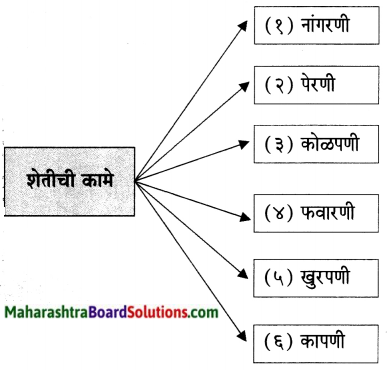
12. खालील तक्ता पूर्ण करा.
प्रश्न 1.
खालील तक्ता पूर्ण करा.

उत्तर:
| लोखंडी वस्तू |
काचेच्या वस्तू |
लाकडी वस्तू |
मातीच्या वस्तू |
| 1. खुर्ध्या |
ग्लास |
खुर्ध्या |
घागर |
| 2. पलंग |
बाटली |
टेबल |
माठ |
| 3. सुया |
मूर्त्या |
पलंग |
रांजण |
| 4. टाचण्या |
फुलदाणी |
कपाट |
हंडी |
| 5. चाकू |
आरसा |
खेळणी |
खेळणी |
| 6. कात्र्या |
बरणी |
बैलगाडी |
भांडी |
| 7. गाड्या |
बांगड्या |
नांगर |
कुंड्या |
| 8. मोटारी |
बशी |
कुळव |
घरे |
| 9. आगगाड्या |
दिवे |
पाट |
फुलदाण्या |
| 10. विमाने |
घड्याळ |
दरवाजे |
बरणी |
13. जमिनीच्या खाली येणारी पिके व जमिनीच्या वर येणारी पिके यांची माहिती करून घ्या. त्यांची यादी तयार करा.
प्रश्न 1.
जमिनीच्या खाली येणारी पिके व जमिनीच्या वर येणारी पिके यांची माहिती करून घ्या. त्यांची यादी तयार करा.
उत्तरः
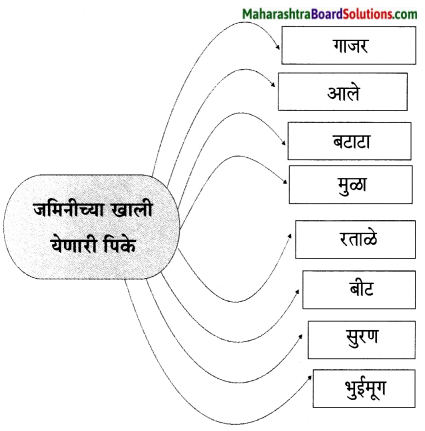
14. खालील वस्तूंपासून तुमच्या घरी कोणकोणते पदार्थ तयार केले जातात. याविषयी आपापसांत गप्पा मारा.
प्रश्न 1.
खालील वस्तूंपासून तुमच्या घरी कोणकोणते पदार्थ तयार केले जातात. याविषयी आपापसांत गप्पा मारा.

उत्तरः
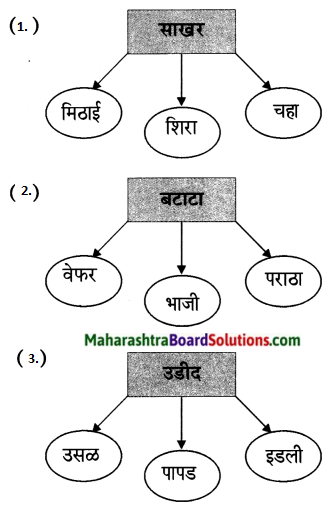
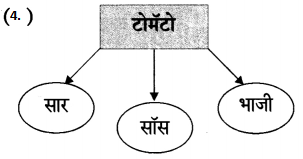
15. मोठ्या आईपासून प्राप्त होणाऱ्या गोष्टी लिहून आकृती पूर्ण करा.
प्रश्न 1.
मोठ्या आईपासून प्राप्त होणाऱ्या गोष्टी लिहून आकृती पूर्ण करा.
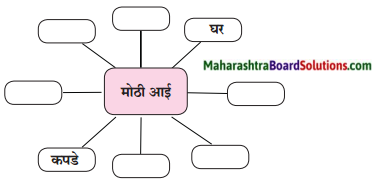
उपक्रम: आई, मातृभूमी या विषयावरील कवितांचा संग्रह करून त्या कवितांचे वर्गात वाचन करा.
प्रकल्प: शिक्षक किंवा पालकांच्या मदतीने जवळच्या शेताला भेट दया. शेतात येणाऱ्या विविध पिकांचे निरीक्षण करून शेतातील अन्नधान्याबद्दल माहिती मिळवा.
उत्तरः
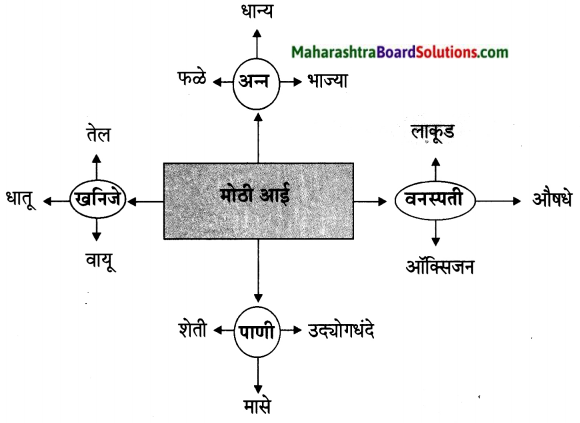
16. खालील वाक्यांत (?, !, ‘-‘, “-“, . , ,) ही विरामचिन्हे घालून वाक्ये पुन्हा लिहा.
प्रश्न अ.
आवडले का तुला पुस्तक आई म्हणाली.
उत्तर:
“आवडले का तुला पुस्तक?” आई म्हणाली.
प्रश्न आ.
तो प्रामाणिक आहे बाबांनी सांगितले.
उत्तर:
तो ‘प्रामाणिक’ आहे बाबांनी सांगितले.
प्रश्न इ.
गणू म्हणाला अगं आई उदया सुट्टी आहे असे दिनूने सांगितले म्हणून मी शाळेत गेलो नाही
उत्तरः
गणू म्हणाला, “अगं आई, उदया सुट्टी आहे, असे दिनूने सांगितले. म्हणून मी शाळेत गेलो नाही.”
प्रश्न ई.
अहाहा किती छान चित्र आहे.
उत्तर:
अहाहा! किती छान चित्र आहे!
प्रश्न उ.
तुला लाडू आवडतो भका.
उत्तर:
तुला लाडू आवडतो का?
प्रश्न ऊ.
माझे काका मुंबईला राहतात
उत्तरः
माझे काका ‘मुंबईला’ राहतात.
प्रश्न ए.
मधू राजा रझिया व मारिया गप्पा मारत बसले
उत्तर:
मधू, राजा, रझिया व मारिया गप्पा मारत बसले.
Class 6 Marathi Chapter 13 मोठी आई Additional Important Questions and Answers
रिकाम्या जागी योग्य शब्द भरून वाक्य पूर्ण करून लिहा.
प्रश्न 1.
आपली आई आपल्यावर किती …………… करते.
उत्तर:
माया
प्रश्न 2.
तिचे नाव भूमी ! ……………!
उत्तर:
जमीन
प्रश्न 3.
माती आहे म्हणूनच आपण …….. आहोत.
उत्तर:
जिवंत
प्रश्न 4.
जेवणाच्या ताटातला प्रत्येक ………….. मोठ्या आईने दिला.
उत्तर:
जिन्नस
प्रश्न 5.
दाराच्या कड्या, तुळया व बिजागऱ्या आहेत.
उत्तर:
लोखंडी
प्रश्न 6.
त्या मोठ्या आईचे केवढे …..मानले पाहिजेत!
उत्तर:
उपकार
प्रश्न 7.
त्या भूमीतले …………….. खाऊनच आपण मोठे झालो.
उत्तर:
अन्न
प्रश्न 8.
माणसांना प्रत्येक गोष्ट दिली ती या …………………
उत्तर:
भूमीनेच
प्रश्न 9.
त्या मायभूमीबद्दल आपण मनात नेहमी ………………….. बाळगावयास नको का?
उत्तर:
प्रेमभाव
प्रश्न 10.
पली मोठी ………………… म्हणजेच आपली मायभूमी!
उत्तर:
आई
खालील प्रश्नांची एक ते दोन वाक्यात उत्तर लिहा.
प्रश्न 1.
आपल्या आईहूनही एक मोठी आई आहे ती कोण?
उत्तर:
आपल्या आईहूनही एक मोठी आई आहे, तिचे नाव ‘भूमी! जमीन’!
प्रश्न 2.
जमिनीत काय आहे?
उत्तर:
जमिनीत माती आहे.
प्रश्न 3.
आपण आज जिवंत कोणामुळे आहोत?
उत्तर:
माती आहे म्हणून आज आपण जिवंत आहोत.
प्रश्न 4.
जेवणाच्या ताटातला प्रत्येक जिन्नस आपणास कोणी दिला?
उत्तर:
जेवणाच्या ताटातला प्रत्येक जिन्नस आपणास मोठ्या आईने दिला.
प्रश्न 5.
गहू, तांदूळ व जोंधळे कोठे तयार होतात?
उत्तर:
गहू, तांदूळ व जोंधळे आपणास शेतातूनच म्हणजेच मातीतून मिळतात.
प्रश्न 6.
कापूस कोठून मिळतो?
उत्तर:
कापूस कपाशीच्या झाडापासून मिळतो.
प्रश्न 7.
रेशीम कोठून मिळते?
उत्तर:
रेशीम रेशमाच्या किड्यापासून मिळते.
प्रश्न 8.
रेशमाचे किडे कोणत्या झाडावर जगतात?
उत्तर:
रेशमाचे किडे तुतीच्या झाडावर जगतात.
प्रश्न 9.
प्रत्येक गिरणी व प्रत्येक कारखाना कशामुळे चालतो?
उत्तर:
प्रत्येक गिरणी व प्रत्येक कारखाना लोखंड व कोळसा यामुळे चालतो.
प्रश्न 10.
विटा कशापासून बनवल्या जातात?
उत्तर:
विटा लाल मातीपासून बनवल्या जातात.
प्रश्न 11.
लाकूड कोठून आणतात?
उत्तर:
मोठमोठ्या रानांतील वाळलेली प्रचंड झाडे तोडून लाकूड आणतात.
प्रश्न 12.
गाई-म्हशींपासून आपण काय मिळवतो?
उत्तर:
दूध, दही, तूप आपण गाई-म्हशींपासून मिळवतो.
प्रश्न 13.
गाई-म्हशी कशावर जगतात?
उत्तर:
गवत व कडबा यांवर गाई-म्हशी जगतात.
व्याकरण व भाषाभ्यास.
प्रश्न 1.
एक- अनेक लिहा.
- गोष्ट
- छान
- जिन्नस
- घर
- भूमी
- फूल
- औषध
- झाड
- कापूस
- रूपे
- दागिने
- उत्तर
- दार
- प्रचंड
उत्तर:
- कथा, कहाणी
- सुंदर
- नग, वस्तू
- सदन
- जमीन
- पुष्प, सुमन
- दवा
- वृक्ष, तरू
- कपासी
- चांदी
- अलंकार
- जवाब
- दरवाजा
- मोठा
प्रश्न 2.
एक – अनेक लिहा.
उत्तर:
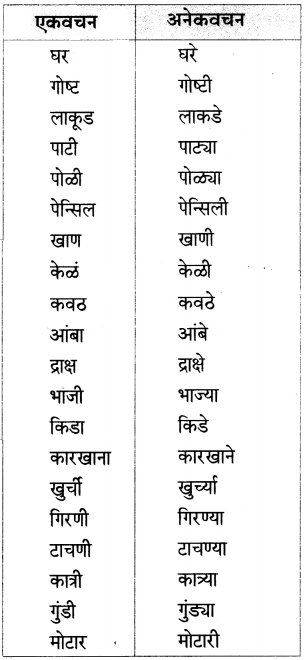
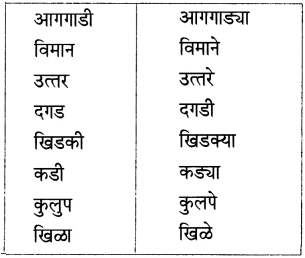
प्रश्न 3.
पाठात आलेले जोडशब्द शोधून लिहा.
उत्तरः
- जिन्नस
- प्रचंड
- प्रत्येक
- खुर्ध्या
- काव्या
- गुंड्या
- तुळ्या
- गोष्ट
- उत्पन्न
- वस्त्र
- कड्या
- म्हशी
- अन्न
- पेन्सिल
- टाचण्या
- साऱ्या
- धनधान्य
- पाटीपेन्सिल
प्रश्न 13.
खालील वस्तूंपासून तुमच्या घरी कोणकोणते पदार्थ करतात ते वेब मध्ये लिहा.
उत्तरः
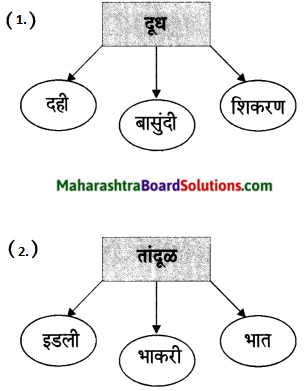
लेखन विभाग
प्रश्न अ.
जमिनीच्या वर येणारी पिके यांची यादी खालील वेबमध्ये लिहा.
उत्तरः
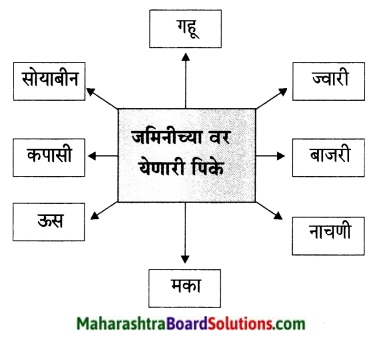
मोठी आई Summary in Marathi
काव्य परिचय:
आपल्या आईपेक्षाही आपणास अजून एक मोठी आई असते. ती म्हणजे ‘भूमी ! जमीन!’ याच आईचा मोठेपणा या पाठात लेखिकेने गायला आहे. आज आपण सर्व व आपणास जन्म देणारी आई ही सुद्धा याच आईची लेकरे आहेत. तिनेच आपणास या सर्व वस्तू पुरवल्या आहेत. ती नसती तर आपले अस्तित्वच या भूतलावर नसते आणि म्हणून त्या भूमीविषयी कृतज्ञतेची भावना आपण सतत मनात जपली पाहिजे हाच संदेश या पाठातून लेखिकेने दिला आहे.
शब्दार्थ:
- आई – माता,जननी (mother)
- माया – प्रेम, ममता (love)
- पोटोशी – गरोदर (pregnant)
- गोष्ट – कथा (story)
- स्वरूप – रूप (charm, beauty)
- जिन्नस – वस्तू (an article)
- भूमी – जमीन, धरित्री, धरती (Land, earth)
- जोंधळा – ज्वारी (jowar)
- पाटी – (slate)
- ऊस – (sugarcane)
- तुतीचे झाड – (murberry tree)
- सापडणे – मिळणे (to be found)
- लोखंड – लोह (iron)
- गिरणी – मिल (a mill)
- खांब – स्तंभ (a pillar)
- दार – दरवाजा (a door)
- खिडकी – झरोका (window)
- तुळई – घराच्या मध्यावरील लाकूड
- बिजागरी – सांधपट्टी (hinger)
- कडबा – कणसे कापून घेऊन उरलेला गुरांना खाण्याचा भाग, वैरण (fodder)
- दागिने – अलंकार (jewellery)
- मायभूमी – पृथ्वी (motherland)
- भांडीकुंडी – छोटी मोठी भांडी (vessles and pots)
वाक्प्रचार व अर्थ:
- माया करणे – प्रेम करणे.
- लक्षात येणे – कळणे, समजणे, ध्यानात येणे.
- प्रेमभाव बाळगणे – मनात प्रेम बाळगणे.
Marathi Sulabhbharati Class 6 Solutions
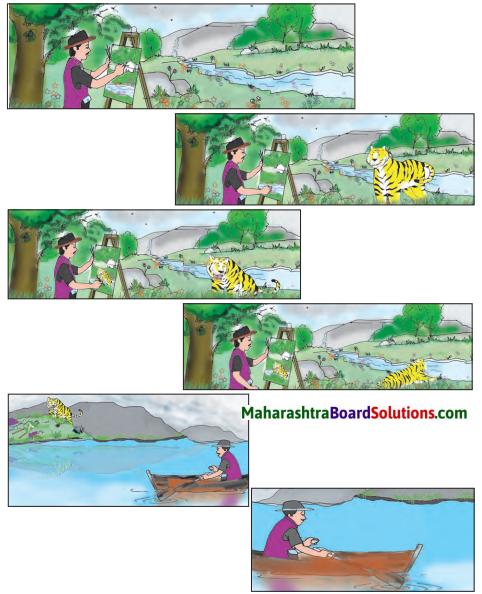
![]()
